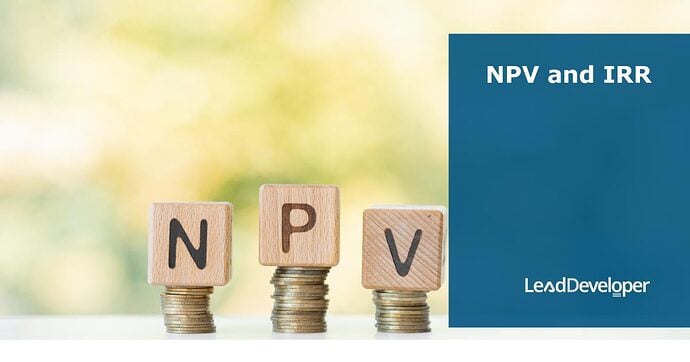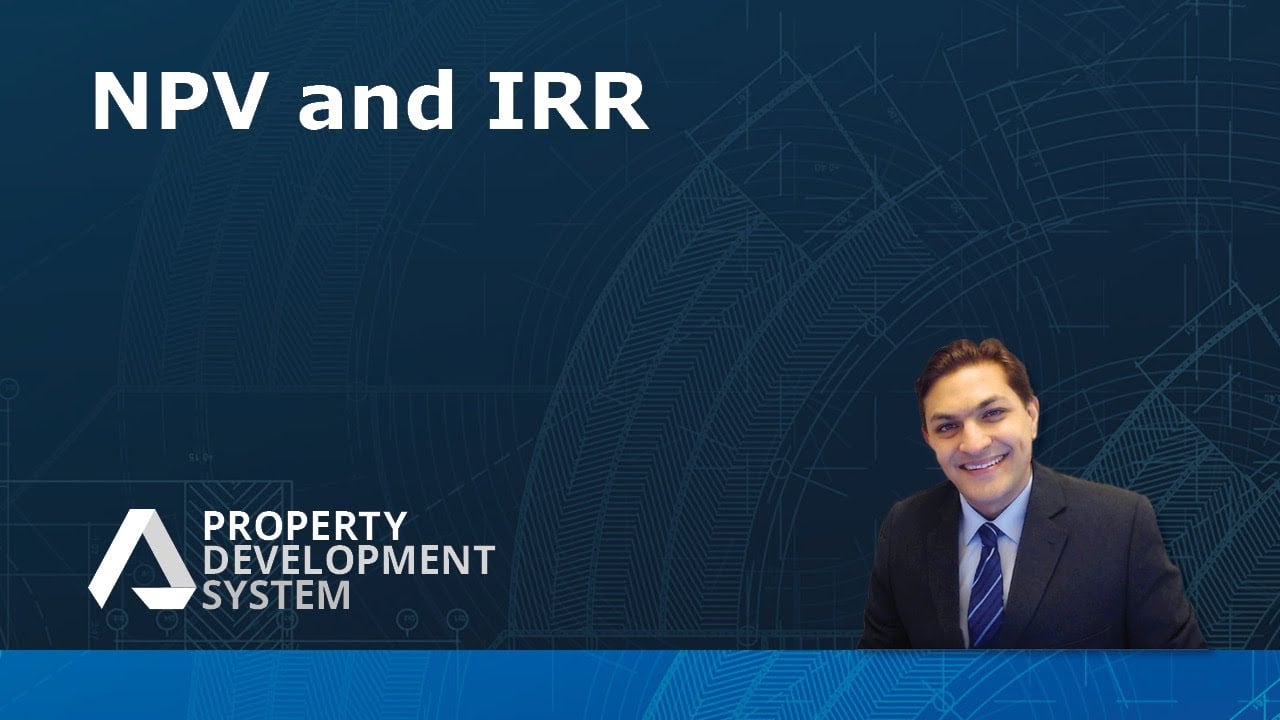NPV and IRR
Here is an insightful exploration into the concepts of Net Present Value (NPV) and Internal Rate of Return (IRR), crucial metrics in the realm of finance and investment analysis. Through examples, it clarifies how these metrics influence investment decisions, distinguishing between levered and unlevered cash flows and illustrating the impact of investment timing on returns.
Levered vs. Unlevered Cash Flow
The video begins by differentiating between levered (after financial obligations) and unlevered (before financial obligations) free cash flow. Levered cash flow considers financial obligations, while unlevered does not.
IRR & NPV Concepts
The internal rate of return (IRR) is presented as the expected rate of return on a property, given its projected cash flows over the holding period. Net Present Value (NPV) measures how far off an investment is from the investor’s desired rate of return.
Example Analysis
An example is provided to illustrate how IRR and NPV calculations can impact investment decisions. In the example, a project with an IRR of 10.73% and varying NPV figures (-$43,000 in levered, $320,000 in unlevered scenarios) demonstrates how these figures influence investment attractiveness.
Investment Implications
The video explains that a positive NPV indicates a potentially good investment, whereas a negative NPV suggests walking away from the project. It further elaborates that the IRR tells us the return on our projected cash flow, while the NPV quantifies adjustments needed to reach the target yield.
Insights based on numbers
Investment & Returns
The initial investment of $515 and monthly returns are analysed to derive the IRR over 10 months, highlighting the precise figures of returns in different scenarios.
NPV Calculations Impact
Through a detailed example, the video illustrates the significant impact of NPV figures on investment decisions, showing how these figures can guide whether to proceed or abandon a project.
Time Factor in Investments
The explanation emphasises the importance of considering the time factor in investments, as illustrated by the differences between return on equity and IRR due to the timing of cash inflows.
Frequently Asked Questions
What is the difference between return on equity and IRR concerning time?
Return on equity is presented as a measure of the total return that investors, as a group, receive on their original investment without considering the time value of money. In contrast, IRR is described as an annualised return over a period of time, inherently accounting for the time value of money. This distinction highlights that while return on equity might give a snapshot of returns without time consideration, IRR provides a more comprehensive view by incorporating how the timing of cash inflows and outflows affects the overall return on investment.
IWhat is the he use of IRR and NPV in evaluating real estate investments?
IRR is used to estimate the expected rate of return on a property, considering its projected cash flows over the investment period. NPV, on the other hand, helps investors understand how far their potential investment is from achieving their desired rate of return, by comparing the present value of cash inflows with the initial investment cost.
What are NPV and IRR?
Net Present Value (NPV) and Internal Rate of Return (IRR) are key metrics used in finance and investment analysis. NPV calculates the difference between the present value of cash inflows and the amount of investment, showing how much an investment exceeds or falls short of the desired rate of return. IRR is the expected rate of return on an investment, given its projected cash flows.
How do NPV and IRR influence investment decisions?
NPV and IRR are critical for assessing the attractiveness of an investment. A positive NPV indicates that the investment could yield returns above the target rate, making it a potentially good choice. Conversely, a negative NPV suggests the investment may not meet the desired returns, hinting at a reconsideration. The IRR provides a percentage return expected from the investment, helping investors compare against their required rate of return.
How does investment timing affect returns?
The timing of cash inflows can significantly impact the returns of an investment, affecting both the return on equity and the internal rate of return (IRR). Early inflows generally improve an investment’s attractiveness by increasing the present value of future cash flows, thereby potentially raising the IRR and NPV.
What does a positive NPV indicate?
A positive NPV indicates that the investment is expected to generate a return greater than the target yield. It suggests that after accounting for the present value of future cash flows and subtracting the initial investment, there’s a surplus, making the investment potentially attractive.
How does the IRR tell us about the return on our projected cash flow?
The IRR represents the expected annualized return on the projected cash flows of an investment. It’s the rate at which the NPV of all cash flows (both incoming and outgoing) from a project equals zero. In simpler terms, it’s the break-even interest rate that makes an investment worthwhile, providing a clear percentage return expectation.
Why is considering the time factor in investments important?
Considering the time factor is essential because money has a time value. The sooner an investment begins generating cash flows, the more valuable those flows are, due to the potential for reinvestment or use in other areas. This consideration affects the overall attractiveness and feasibility of an investment, as it impacts both NPV and IRR calculations.
Test Your Knowledge
Multiple-Choice Questions on NPV and IRR
1. What does Net Present Value (NPV) measure in investment analysis?
A) The total amount of cash flow over the investment period.
B) The profitability of a project after accounting for the cost of capital.
C) The difference between the present value of cash inflows and the initial investment.
D) The expected rate of return on an investment.
2. Which of the following best describes Internal Rate of Return (IRR)?
A) The discount rate that makes the NPV of all cash flows from a project equal to zero.
B) The actual amount of profit an investment will generate.
C) The yearly interest rate earned on the invested capital.
D) The percentage of return expected from an investment in bonds.
3. How does levered cash flow differ from unlevered cash flow?
A) Levered cash flow is calculated after taxes, while unlevered is before taxes.
B) Levered cash flow accounts for financial obligations, while unlevered does not.
C) Unlevered cash flow includes dividend payments, while levered does not.
D) Levered cash flow is the total income from the investment, while unlevered is the net income.
4. What implication does a positive NPV have for an investment?
A) It suggests the investment will lose money over time.
B) It indicates the investment’s return exactly matches the desired rate of return.
C) It suggests the investment is potentially a good one, with returns above the target rate.
D) It means the investment is risk-free.
5. How does the timing of cash inflows affect the investment’s returns, as per the video?
A) Later, cash inflows increase the NPV due to higher interest accumulation.
B) Timing of cash inflows has no significant impact on the investment’s returns.
C) Earlier cash inflows are more valuable, potentially increasing the IRR and NPV.
D) Only cash inflows in the first year affect the investment’s returns.
6. In the provided example, how did the IRR and NPV figures influence the decision on an investment’s attractiveness?
A) The IRR alone determined the project’s failure or success.
B) A positive NPV in one scenario suggested the investment could be good, despite a negative NPV in another.
C) The varying NPV figures had no impact since the IRR was constant.
D) Only the levered NPV figure was considered for making a decision.
7. Why is considering the time factor important in investment decisions?
A) Because it determines the legal period for an investment.
B) It affects the calculation of the IRR, making early inflows more beneficial.
C) Because investments with shorter durations always have higher returns.
D) It influences the risk factor, with longer investments being riskier.
Answers
- C) The difference between the present value of cash inflows and the initial investment.
- A) The discount rate that makes the NPV of all cash flows from a project equal to zero.
- B) Levered cash flow accounts for financial obligations, while unlevered does not.
- C) It suggests the investment is potentially a good one, with returns above the target rate.
- C) Earlier cash inflows are more valuable, potentially increasing the IRR and NPV.
- B) A positive NPV in one scenario suggested the investment could be good, despite a negative NPV in another.
- B) It affects the calculation of the IRR, making early inflows more beneficial.
Assignment
Practical Exercise on NPV and IRR
Objective:
The aim of this practical exercise is to deepen your understanding of Net Present Value (NPV) and Internal Rate of Return (IRR) through hands-on calculation and analysis, leveraging the concepts of levered vs. unlevered cash flows and the impact of investment timing on returns.
Instructions:
Understanding Concepts:
Write a brief explanation of what NPV and IRR are and why they are important in investment decision-making. Include the difference between levered and unlevered cash flows in your explanation.
Calculation Exercise:
Assume you are evaluating a project with an initial investment of $100,000. The project is expected to generate the following cash flows at the end of each year for five years: $20,000, $30,000, $40,000, $30,000, and $10,000.
Calculate the project’s NPV assuming a discount rate of 10%. Show your work.
Calculate the IRR of the project. You may use financial calculators or software that can compute IRR based on cash flows.
Analysis Based on Scenarios:
Using the same project from the calculation exercise, create two scenarios:
A) The project is levered: Include an annual financial obligation of $5,000.
B) The project is unlevered: No financial obligations.
Recalculate the NPV for both scenarios using the same discount rate of 10%. Discuss how the levered vs. unlevered scenario affects the NPV.
Impact of Investment Timing:
Imagine that for the same project, the timing of the cash inflows is accelerated by one year, meaning the cash flows start occurring from the end of the first year. Calculate the new NPV and IRR for the unlevered scenario.
Discuss how changing the timing of cash inflows affects the project’s attractiveness.
Research and Reflection:
Research an example of a real-world investment decision where NPV and IRR were used. Summarise the investment, the decision made, and how these metrics influenced the decision.
Reflect on the limitations of NPV and IRR in investment decision-making. Consider factors such as project risk, cash flow uncertainty, and the discount rate selection.
To Do:
- Compile your calculations, analyses, and research findings into a structured report.
- Include charts or tables to represent your calculations visually, if possible.
- Provide a conclusion section where you summarise what you have learned from the exercise and how it applies to the field of finance and investment.
Deliverable:
Submit a report covering all the above instructions. The report should be between 5-10 pages long, including any appendices or references. Ensure your explanations are clear and your calculations are accurate and well-presented.
Assessment Criteria:
- Accuracy of NPV and IRR calculations.
- Depth of analysis in levered vs. unlevered scenarios and the impact of investment timing.
- Quality of research on real-world application of NPV and IRR.
- Critical thinking in reflecting on the limitations of NPV and IRR.
- Clarity and structure of the report.



